#which then produced Star Trek
Text

is this too niche
#explanation:#revolution meant that desi arnaz had to escape to USA#where desi met lucille ball#and they wanted to work/stay together which meant creation of I love Lucy#as well as desilu productions#which then produced Star Trek#and Star Trek fans are then credited for inventing slash fiction#Star Trek tos#the original series#spirk#trekposting
9K notes
·
View notes
Text
yeah okay i finished episode 4 of the live action atla series and... i'm not in a hurry to keep watching. i was moderately happy with the first episode and was hopeful that we'd continue uphill as with the original series but atm nothing is really compelling me to keep watching. it's not a train wreck by any means and there have been a few good scenes but it's just incredibly milquetoast. i knew and even hoped that it would be different to the original series but i feel like the priority was to cover as many plot points/moments of the original atla and forgetting about the core of the characters and relationships. when... if you're going to do any sort of decent remake it should be the other way around. i would much rather we forget about episodes/plots like Jet and the Tinkerer and Secret Tunnel and Omashu/Bumi and create new stories that take the characters on a similar emotional journey. i do like the new Aang and i think the actor is doing really well but it just feels wrong that his arc this season is about wanting to save the Northern Water Tribe and we ignore his conflict aversion and y'know. him actually learning waterbending. and it's been said before but Katara's character is just completely unrecognizable from her original character. i feel like the writers chose to remove some of her bossy and overbearing traits to avoid sexism? i guess? same with Sokka. (ignoring the fact that even if it was clumsy, the original series very much did deal with the sexism it presented.) but i think the series just forgot to give Katara other character traits.
the look of the series is great and nothing is bad, it just was so afraid of being like The Movie That Doesn't Exist or betraying the fans that it was caught in a weird place where it was mimicking the original series & avoiding risks without trying to actually capture the characters. in other words – pretty typical remake/sequel syndrome. i'll probably get around to watching it sometime but i'm not in any hurry.
#the katara stuff is the only thing that's making me actually mad. the rest is just. very meh.#the good thing is that every time i watch it i go “oh i should rewatch the original”#i know there are some animated series in the works that AREN'T a remake and i really hope they actually happen#tho i believe paramount is producing them so... i'm not holding my breath#atla#my posts#going back to infinite star trek rewatch which does in fact compel me more than this
4 notes
·
View notes
Photo



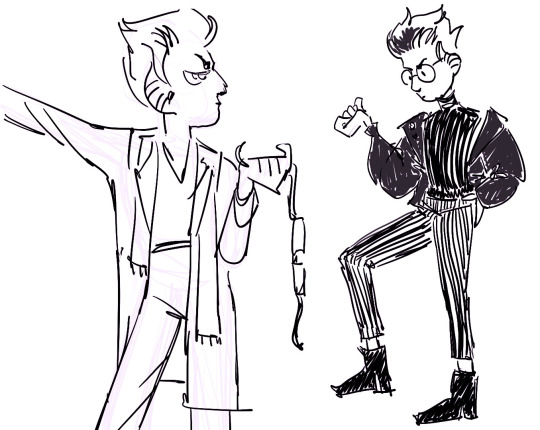

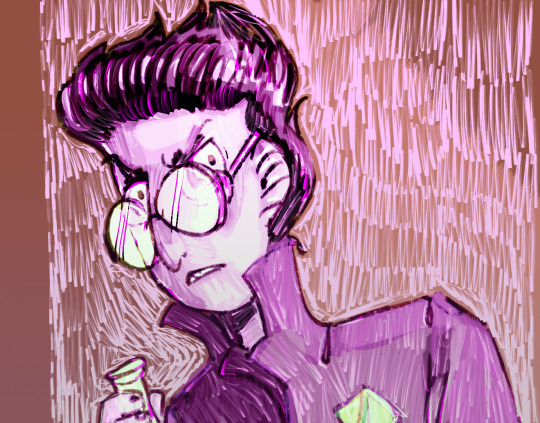
collection of sketches, new and old, of my vorta scientist oc zeveth :^)
#star trek#deep space nine#ds9#vorta#oc#zeveth tag#im obsessed w her. im obsessed w her. ZEVETH!! her voice claim is alison moyet and i cant shut up about it#( *yaz(oo) especially )#some of these are set in the 70s au 'dominion records' by xiaopeng on ao3 PLEASE GO READ MY FRIENDS GODLY FIC EVEN IF U DONT KNOW STAR TREK#zev appears in ch 5 and xiao got her down PERFECTLY.#shes also going to be in 'criminal records' (minions 2) which i SWEAR i am writing wheahha#and: she appears in kind of an alternate version in my sheridan bumper project haha#anyway. free of charge to ask abt my mad scientist vorta oc gFDKGF#shes close to The Founder and got her little claws in development of the white and in vorta genetics yahOOOOO#in 70s au finds her stride in the 80s and then produces in place of lab work. but first answers phones for DR for 5293493 years <3#indigo art /#indigo ocs /#long post /
70 notes
·
View notes
Text
It is done!
So... I was thinking of making these all chapters of a larger fic. The Soji portion was a little over 1.5k words, the Raffi part was just over 3k. The Rios "chapter" is finished as a first draft and is currently at 6.627 words.
...
I have a problem, people 🙈
(And the Soji one is at least as good as the others. It's just... so difficult not to indulge. But then again, I'm not writing these things fro the dense plotting...
Ah well. We'll see what eventually ends up on AO3. But for now: here is a snip*!)
*(unsurprisingly, it's much too long to realistically call a "snippet")
---
Rios’s voice was a perfect imitation of Steward’s Southern Drawl, and Emil nearly gasped.
But the captain wasn’t done. When he spoke again, he was using a lilting accent that the EMH couldn’t place. “It’s like this, see, these programmers know where’n get the bestest voices. They’re smarter-er than youse would ever think. Or mays-be youse are just über-dim…”
Once again, and against his will, Emil burst out laughing. “What was that?”
Rios grinned. “Sixteen-year-old Tellarite. Or the equivalent age for their species, anyway. Teenagers. The UT had one hell of a time trying to translate their speech patterns. We tried to learn some of their expressions, but they informed us we were ‘depleted’, which I think means ‘embarrassing?’”
Emil shook his head. “When did you have a chance to observe Tellarite teenagers? I understand they don’t often leave Tellar before they come of age?”
“Oh, we were shuttling them around on a school trip. Some big interstellar youth debate competition — which they won, of course. Wiped the floor with the Klingon delegation; it was brutal.” Rios smiled at the memory. “They gloated the entire week-long trip back home and decided that newly-minted Starfleet officers were a worthy substitute target for practice. So we had plenty of time listening to them as they grilled us on the finer points of UFP diplomacy protocols. According to Vaasiir chim Ners, we’re all a disgrace to the uniform and should be retroactively failed for our Academy finals.” Rios’s smile started to fade as his eyes became unfocused, looking into the middle distance.
“Captain?” the EMH asked and reached out to touch Rios’s shoulder.
The captain shuddered at the touch, but he focused his attention back on Emil. His smile turned rueful as he said: “Sorry, I just… I guess I just realized she must be an adult by now… I wonder what became of her. And the rest of them…”
Emil was sure Rios was not just referring to the teenage Tellarites, but he could also see all the signs of rapidly growing exhaustion on the captain’s face. Probably best not to let him dwell on these particular questions.
He squeezed Rios’s shoulder and gave him an encouraging smile. “Wherever Ms chim Ners is now, I’m sure she’d be delighted to have left such a lasting impression. I don’t think I’ll ever be able to listen to Ian talk about ‘depleted’ plasma reserves with a straight face again.” Emil tried to imitate the way the captain had said the word, and Rios actually smiled even if there was still a wistfulness to it.
“That pronunciation was awful,” he said. “Don’t ever try to use it with a Tellarite teenager. They’ll mock you so fiercly over it, you’ll never be able to scrub it from your memory files.”
“At least I don’t sound like some ‘über-dim’ debate nerd.” Even as he said it, Emil could tell his accent on the slang term sounded nothing like it was supposed to.
Now, Rios was the one startled into a burst of laughter. “How are you so bad at this? We have the same voice, couldn’t you just copy the way I said it?”
Emil crossed his arms, suddenly feeling rather defensive. “I’m so sorry, I would allocate more of my processing to linguistic shenanigans, but unfortunately it’s bound up in all this pesky medical functionality. You know. Useless things like ‘how to keep your captain from dying of asphyxiation’ and ‘you should not tie your patient to the biobed no matter how many times they try to get up even though you told them not to’.”
“It’s okay,” Rios grinned and then continued in a pitch-perfect imitation of Emil’s own, crisp English accent: “We wouldn’t want you to overtax your fragile algorithms.”
For half a second, they both stared at each other, then, as one, they started laughing. Suddenly, their was barely any difference left between their voices.
#the emotional rollercoaster continues 🙈#this probably needs drastic editing and shortening#but then again i try to keep telling myself i'm not trying to produce Great Literature#i am writing silly self-indulgent stories for myself and my internet friends#but mostly myself (and in this case jazzfic since this is still technically based on her prompt...)#so 6.5k of nothing but snark emotional ups and downs and doctoring is allowed#anyway#cristobal rios#emil (emh)#alien linguistics#sort of#maybe more: alien teen speak#star trek picard#lili's writing adventures#writing accountability#bed rest#(which is the tentative name for this fic/series of fics if this keeps escalating like it has...)#memory loss#emotional hurt/comfort
8 notes
·
View notes
Text
far too loud inside my head again!
#news from the cupola#the kind of loud that makes everything I try to write on immediately unpalatable to me#which is Unfortunate because I want those things to be cool and fun so very desperately#but instead. scribble. produce nonsense. eat poptart. repeat.#the 'can I restore my soul via excessive midday star-trek-watching' challenge begins once more
6 notes
·
View notes
Text
Star Trek people who are more knowledgeable than me, I’d love to hear what your opinion is about what would happen if a betazoid and a vulcan tried out a romantic relationship. I feel like that would either be insane (good) or insane (bad)
Kinda bounding off of that, into a situation that’s mostly the same but somewhat different: this time assume both are mixed heritage, so like a half human, half vulcan, and a half human, half betazoid. Does that change anything?
#Star Trek#I don’t think they could make it work if they were strictly raised in their cultures. bc that’s emotional suppression vs embracing emotions#and it just wouldn’t work#but then I was thinking of someone like Spock who struggles to maintain his emotional control#and if it would be ‘appreciated’ to have a partner who has that empathy ability (which I read is only produced in half human half betazoid?)#like the vulcan wouldn’t have to verbalize his emotions. the betazoid would just know#assuming the betazoid would be okay with keeping a secret lol#it’s 2am#I don’t think any of this makes sense#goodnighttttt
0 notes
Text
Imagine a Star Trek type food replicator that lacks an internal library of approved outputs and instead uses a generative language model to figure out what you're asking for. People having to do Midjourney-style prompt crafting to get the meals they want out of it. Abusing the system by describing things that absolutely are not food in ways which circumvent the safeguards. Occasionally it produces something that tries to eat you back which it insists with perfect confidence is in fact a strawberry crumble.
4K notes
·
View notes
Text
What makes JKR's shitshow even harder to process is that she didn't just ruin a book series. Harry Potter was an entire subculture. Like Star Wars and Star Trek fans, Harry Potter fans dedicated their lives and careers to the series. I don't know if I'd call it "underground," but liking Harry Potter got you beaten up when I was in school, so it was more of a dedicated indie culture than a mass-appeal fanbase.
Harry Potter was so huge that fan works developed their own followings. Potter Puppet Pals racked up hundreds of thousands of followers and was nearly as relevant as the series itself. For fanfiction, Harry Potter and the Methods of Rationality got so big that it has a Wikipedia page. The band Harry and the Potters spawned the wizard rock music genre. A Very Potter Musical developed a fanbase and launched Darren Criss's career.
Harry Potter also has extensive ties to fandom history. Everyone in my generation (millennials) remembers coming home from school to read Harry Potter fanfiction on the Internet. Today, most people just post their stories on Wattpad or Archive of Our Own. But at the time, the fanbase was splintered between fanfiction.net and dozens of individual websites and forums, some made for specific ships. Since they all had individual hosts, a lot of those sites have been lost to time.
And there's the infamous My Immortal fanfiction, which is an Internet legend with people still searching for the author. Everybody read that one (and laughed at it) in middle school.
Pre-social media, fan sites like The Leaky Cauldron and Mugglenet had massive followings because they were one of few sources for news, theories, essays and fan content. Some of these sites still exist after being around for over a decade and building their own legacy.
Before Deathly Hallows came out, fans were so desperate to know what happened that Mugglenet published a book called What Will Happen in Harry Potter 7: Who Lives, Who Dies, Who Falls in Love and How Will the Adventure Finally End? Yep...Harry Potter was so big that people wrote separate books about what would happen in an upcoming book.
And that's not mentioning all the book release parties, Harry Potter-themed events, monuments, fan films, restaurants and even a theme park. A lot of fandoms have those, but Harry Potter infiltrated every aspect of popular culture.
Today, there's a thriving culture of "Harry Potter adults" with themed weddings, baby showers and Etsy stores. Putting your Hogwarts house in your Instagram bio is pretty much a prerequisite for joining the "bookish" community. Warner still produces new content, like the Fantastic Beasts series, although we've all seen what a disaster that's been.
Everyone has at least a few memories associated with Harry Potter even if it's just watching the movies. I had great memories associated with Harry Potter. But looking back at the subculture, history and thousands of fan works, it doesn't seem fun anymore. Studying the fandom or being part of it comes with an awkward tension because you don't want to seem like you're condoning JKR's bigotry but can't divorce her from the series. This subculture was spawned by a woman who turned her legacy of magic and wonder into one of abuse and hatred.
I don't expect people to write paragraphs about how much they hate JKR every time they post about Harry Potter, but it's still uncomfortable to see people make new content or wear their Harry Potter Etsy tote bags like nothing happened. Even if they clarify that they don't support her, it's just a weird, tense situation for everybody.
People dedicated years of their lives to running Harry Potter fan sites, writing fanfiction, cosplaying characters and making fan movies. If I were in that situation, I'd have a mild identity crisis. I'd ask myself "Did I waste all those years? Should I delete my content? Where do I go from here?"
So ultimately, JKR didn't ruin "just" a book series or even "just" a fandom. She tanked an entire culture, which inspired people to look at Harry Potter more critically. The issues that people brought to the light tainted the series's legacy even without JKR's personal issues.
Once, Harry Potter was a series for generations. Now, former fans hope that the series fades into irrelevancy. Unfortunately, JKR didn't just tarnish her legacy--she took decades of history, millions of fans and a worldwide subculture along with her.
43K notes
·
View notes
Text
I've been scanning and restoring some pieces of original Star Trek: TOS film and wanted to share this before and after from a deleted scene in the episode "Elaan of Troyius":


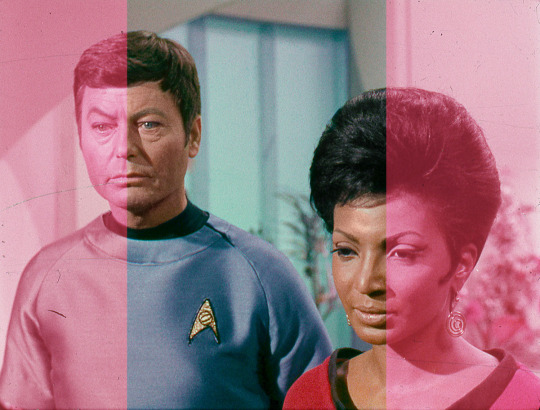

At nearly 60 years old, the film is in bad shape, exhibiting substantial scratches and color shifting. The magenta/red tint is a good example of dye fading, a sign of deterioration likely due to the film stock it was shot on.
Prior to 1950, color motion picture film was shot in Technicolor, which required a large, cumbersome camera to simultaneously expose 3 separate strips of negative film that then underwent a proprietary dye imbibition process to create a full color image. Though visually stunning and remarkably color-stable, it was a complicated, expensive process reserved only for high budget productions. In 1950, Eastman Kodak introduced Eastmancolor, the first 35 mm “single-strip” color motion picture negative -- in short, a film that was easy to shoot and process, and compared to Technicolor, only used a 1/3 of the film stock. Suddenly color film was an affordable option for studios and its popularity took off. Eastmancolor was composed of a single strip of negative film surfaced with 3 layers of light-sensitive gelatin emulsion. During development, a chemical reaction produced magenta, yellow, and cyan dyes on their corresponding layers, which were superimposed to create a full color image. Unfortunately, these dyes were unstable, something that wasn't apparent until aging films began to lose their color in the following years.
The Star Trek image above is pink because its yellow and cyan dyes have faded away, leaving just the magenta layer. The information may be lost, but digital restoration can improve what's left. But because the yellow and cyan greatly contributed to the overall density of the image, basic color balancing still produces a lower contrast version compared to what the original must have looked like. The missing richness and depth seems most apparent in the skin tones, but hand painting some of the color can bring a little life back to it, as I've done here. It's a challenge because, as far as I can tell, the only remaining footage or still shots of this scene show some level of dye fading. Fortunately, now that the film is digitized, restoration can be an ongoing project. If you own any color motion picture film negatives or prints, the sooner you get them scanned the better. In the meantime, helpful storage information can be found here.
It's been a while since I've shot any film (film major), so it's nice to see it again, even if it's chopped up into single frames. I have a small collection of them so I'll post more restored images as they're completed.
BTW @cheer-deforest-kelley has a great post on how this film went from the editing room floor to the hands of fans.
#star trek#star trek the original series#tos#leonard mccoy#deforest kelley#nyota uhura#nichelle nichols#elaan of troyius#film preservation#film restoration#35mm film
2K notes
·
View notes
Text
Star Trek's "Lost" Main Character

Just when you think you know everything there is to know about the original Star Trek, you learn something new, like the fact someone you barely remember was going to be a series regular. Take the case of "Yeoman Smith," played by Andrea Dromm, a petty officer secretary in "Where No Man Has Gone Before." Everyone knows that Trek had a first pilot with a different cast. But the cast of the second pilot was analyzed more in terms of who wasn't there (Dr. McCoy and Uhura were added only when the show went to series and were not in the second pilot at all), than who was.
One character in particular is easy to overlook as she seemed like just another lowly and invisible crewman, Yeoman Smith. Surprisingly, Andrea Dromm was hired to be a main character on the show.
The NBC publicity materials made for the second pilot mentioned and discussed her as they would Kirk and Spock, and treated her as a series regular, which at the time, she was:
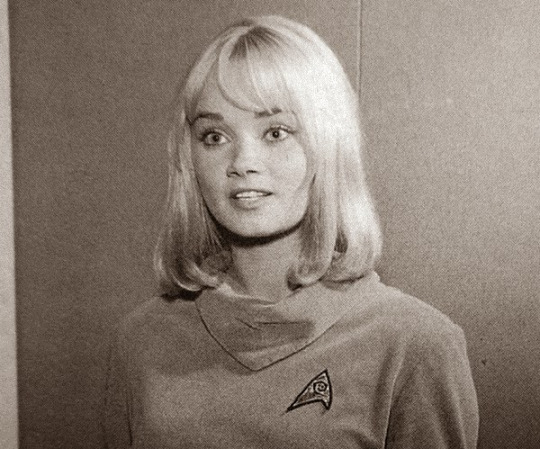
“YEOMAN SMITH, who has drawn the important assignment of secretary to the Captain on her first mission in deep space, is easily the most popular member of Kirk’s staff. A capable secretary and efficient dispenser of instant coffee, she also provides a welcome change of scenery for eyes that have spent long hours scanning the vast reaches of space.”
Almost from the beginning though, it was not to be. Andrea Dromm caused trouble on set because, according to Herb Solow, Gene Roddenberry "hired Dromm so he could 'nail her.'" Trek was in enough trouble, as Roddenberry cast his mistress, Rachel Lee Hudec (aka Majel Barrett), which violated his Desilu "virtue clause." Lucille Ball, embarassed by her former husband Desi Arnaz's well known extramarital antics, insisted on virtue clauses in contracts for creatives.
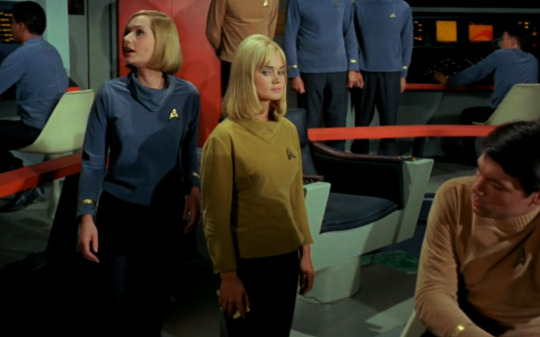
As for what happened and why Yeoman Smith never ended up being a regular, we have two different conflicting stories. Andrea Dromm said she had to choose between making Star Trek, or making a film, "The Russians are Coming," and she picked the movie over a less prestigious tv show. Star Trek producer Herb Solow tells a different story and remembers that "Yeoman Smith" was one of two main characters who were let go to keep costs down when the show went to series. The other main character fired? James Doohan as Scotty.
After being informed he was fired after the first pilot, Doohan called his agent, the physically intimidating and formidable Paul Wilkins, who convinced Roddenberry to return Doohan to the series. It is not known how this was accomplished (Herb Solow, who's memoirs are the basis of most of what we know about early Trek, was not present, only Roddenberry was), but Doohan had his job back within the day.

As for what would have happened with Yeoman Smith if she had stayed as a main character....who knows? The character of Yeoman Rand, well known for her beehive hairdo, was a replacement for her character, so it's likely that Yeoman Smith as a main character would have filled similar roles in stories, probably beat for beat and note for note. All the same however, it's hard to ignore how much more quiet moxie, no-bullshit stares, and extrovert elan Andrea Dromm projected on screen than the more subdued Grace Lee Whitney. Dromm's character was underdeveloped, sure, but so was Scotty and Sulu at that point, and the characters they eventually became were built around their actors' strengths and warmth. It's not hard to imagine something similar might be done with Dromm, and her character might have gone on very different lines from her replacement.
660 notes
·
View notes
Note
read your criticism and have a genuine question about your thoughts on the branding scene. i completely understand how max's branding is inherently tied to a racist history, and it always will be, but i dont feel like the scene itself was written with that bias/intent. thaddeus also gets branded in later episodes and it's implied to happen to every aspirant upon their promotion. at what point in writing are black characters morally barred from specific story points because of their similarities to a history that's not directly related? sort of similar with barb, at what point can black characters not do bad things at all, especially in a story where there are near a dozen non-black characters who do worse things? also considering it's implied (at least, i understood it as) she's sticking to vault-tec to protect her family?
I am not in the best position to comment on this, because I am not black. I will do my best to add what I can, but this is a space for others to chime in.
Barb is interesting because she's essentially become the person who did the most heinous crime in the entire setting- by far and away worse than anything anyone has ever done. There really aren't white characters who did worse things- because all the crimes of Caesar or the Enclave or whoever else pale in comparison to being the one who literally set into motion the total annihilation of all nations on Earth. (This is setting aside her willing participation in the inception of the vault experiments- which is an entirely separate also horrific crime.)
The issue is they've created a setting that is, as presented, colorblind. Race is invisible to the writers, who did not consider it meaningfully while producing the show- as is often the case with white creatives putting characters of color into their stories. Colorblindness does not always produce entirely racist results- and when done with tact and intentionality it can even be revolutionary. Look at the relative inclusivity of star trek as an example, and the radical depiction of Uhura in the original series.
The thing that makes Fallout different from Star Trek however is that it is not depicting its colorblind future with tact and intentionality. This is a show that is intensely concerned with depicting the specific brand of nationalistic American politics of the 1950s and the Cold War- and they've reproduced that system for the show but with a black woman at the head. That's where the issue comes up.
This was a system that had racism baked into it by design. It still does. American Nationalism and corporate violence are built on racism against black people and other minorities. And this show desperately wants to depict these things, but they've decided to put a black woman at the head of them. They're depicting systems that are, by their nature, violently racist- but they've decided to portray them as being run by a black housewife.
Fallout 3 does a similar thing with how it depicts every major slaver as a black person. Eulogy Jones, the slave buyer at Paradise Falls, the head slaver in the Abe Lincoln memorial, Ashur in The Pitt. Hell Mothership Zeta adds in a black woman from the wasteland and even SHE'S revealed to have been a slaver. This is something Bethesda consistently does- depicting ideologies and practices with a deep history of racialized violence- and then showing black people at the head of them, seemingly to try to avoid actually addressing any aspect of racism in their stories outside of hamfisted metaphors like synths and ghouls. (I use Fallout 3 as an example but Fallout 4 does many of these same things.)
Thaddeus does also get branded, and he does also get treated to the same demeaning servanthood as Maximus. The difference, quite frankly, is that Thaddeus is white. There are just some things that are straight up inappropriate to depict happening to black characters without appropriate thoughtfulness and context. Never before this series has the Brotherhood ever done brandings- and yet this show opens with it in the first episode and introduces this brand new jarring concept with the visceral image of a black man being branded by faceless fascist cultists.
It's also important to note that even if they didn't intend the scene as racist, it still is. Like I don't think the scriptwriter sat down and said "oh I'm gonna do a racism" cuz intent just doesn't matter here. The scene was intended as a way of showing the severity of the brotherhood- but it also thoughtlessly reproduces images of historic black violence.
@orange-coloredsky I know you've been talking about this stuff all day, and your initial posts about the antiblack racism in the series were what prompted me to write my thoughts today- which is what this ask is in response to. I was curious if you have any other input with all this.
I'd also be more than happy to have any additional input from people better suited to answer these questions.
183 notes
·
View notes
Text
Remarkable to see Guillermo del Toro’s TALES OF ARCADIA series accounted for 82.7 million hours of viewership on Netflix in the first half of 2023 alone.
Grateful to have been a writer and eventually co-executive producer and co-showrunner on the series. Proud of what our team accomplished — and a little overwhelmed…
… But it proves a hunger for YA adventure animation is out there!
Honestly, this bodes well for STAR TREK: PRODIGY as well, which drops on Christmas Day on Netflix!

#trollhunters#wizards gifs#wizards tales of arcadia#netflix#netflix animation#animation#star trek prodigy
292 notes
·
View notes
Text
y'know what, I think it's kind of interesting to bring up Data from Star Trek in the context of the current debates about AI. like especially if you actually are familiar with the subplot about Data investigating art and creativity.
see, Data can definitely do what the AI programs going around these days can. better than, but that's beside the point, obviously. he's a sci-fi/fantasy android. but anyway, in the story, Data can perfectly replicate any painting or stitch a beautiful quilt or write a poem. he can write programs for himself that introduce variables that make things more "flawed", that imitate the particular style of an artist, he can choose to either perfectly replicate a particular sort of music or to try and create a more "human" sounding imitation that has irregular errors and mimics effort or strain. the latter is harder for him that just copying, the same way it's more complicated to have an algorithm that creates believable "original" art vs something that just duplicates whatever you give it.
but this is not the issue with Data. when Data imitates art, he himself knows that he's not really creating, he's just using his computer brain to copy things that humans have done. it's actually a source of deep personal introspection for the character, that he believes being able to create art would bring him closer to humanity, but he's not sure if he actually can.
of course, Data is a person. he's a person who is not biological, but he's still a person, and this is really obvious from go. there's no one thing that can be pointed to as the smoking gun for Data's personhood, but that's normal and also true of everyone else. Data's the culmination of a multitude of elements required to make a guy. Asking if this or that one thing is what makes Data a person is like asking if it's the flour or the eggs that make a cake.
the question of whether or not Data can create art is intrinsically tied to the question of whether or not Data can qualify as an artist. can he, like a human, take on inspiration and cultivate desirable influences in order to produce something that reflects his view on the world?
yes, he can. because he has a view on the world.
but that's the thing about the generative AI we are dealing with in the real world. that's not like Data. despite being referred to as "AI", these are algorithms that have been trained to recognize and imitate patterns. they have no perspective. the people who DO have a perspective, the humans inputting prompts, are trying to circumvent the whole part of the artistic process where they actually develop skills and create things themselves. they're not doing what Data did, in fact they're doing the opposite -- instead of exploring their own ability to create art despite their personal limitations, they are abandoning it. the data sets aren't like someone looking at a painting and taking inspiration from it, because the machine can't be inspired and the prompter isn't filtering inspiration through the necessary medium of their perspective.
Data would be very confused as to the motives and desires involved, especially since most people are not inhibited from developing at least SOME sort of artistic skill for the sake self-expression. he'd probably start researching the history of plagiarism and different cultural, historical, and legal standards for differentiating it from acceptable levels of artistic imitation, and how the use of various tools factored into it. he would cite examples of cultures where computer programming itself was considered a form of art, and court cases where rulings were made for or against examples of generative plagiarism, and cases of forgeries and imitations which required skill as good if not better than the artists who created the originals. then Geordi would suggest that maybe Data was a little bit annoyed that people who could make art in a way he can't would discount that ability. Data would be like "as a machine I do not experience annoyance" but he would allow that he was perplexed or struggling to gain internal consensus on the matter. so Geordi would sum it up with "sometimes people want to make things easy, and they aren't always good at recognizing when doing that defeats the whole idea" and Data would quirk his head thoughtfully and agree.
then they'd get back to modifying the warp core so they could escape some sentient space anomaly that had sucked the ship into intermediate space and was slowly destabilizing the hull, or whatever.
anyways, point is -- I don't think Data from Star Trek would be a big fan of AI art.
300 notes
·
View notes
Text
Listen, the absolute best thing about Kirk and Spock's dynamic in Star Trek: The Original Series, is the fact that when it aired, queerbaiting was literally not a thing that existed. The writers and producers would not have even fathomed of doing that shit on actual purpose. Which means that all of that homoerotic tension was totally unplanned and completely organic. Just a happy fucking accident. A byproduct of bomb ass on-screen chemistry. And I just think that that's really fucking rad.
#star trek#star trek tos#jim kirk#mr. spock#spirk#the original otp#space husbands#william shatner#and the late great#leonard nimoy#can you guess what im currently bingeing?#again?#for the billionth time?
5K notes
·
View notes
Text
Once again I'm thinking about the symbolic meaning in Michael's hair, particularly in season 1.
Young Michael before and after she started living on Vulcan.

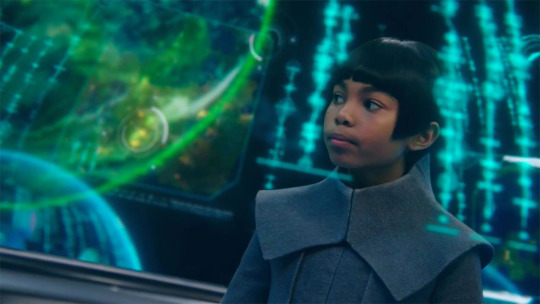
When she's living on Vulcan, and trying to suppress her human self, she straightens her hair and has it in a Vulcan bob. When she's been in Starfleet for awhile the bob disappears but she still straightens it.


When in prison she starts getting a more natural hairstyle, but still have it short and pretty practical. Then eventually we get to her season 4 look.

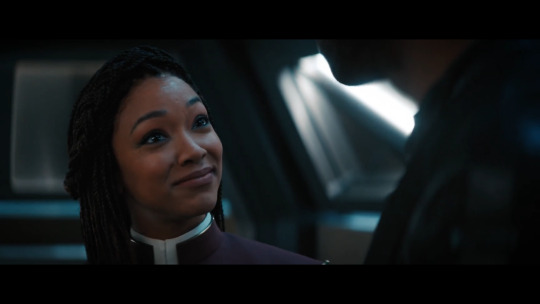
While in real life these changing looks can mean completely different things for different people, the changes here do have a clear connection to the narrative in Discovery. A narrative of self discovery, of becoming a more complete person if you embrace different parts of yourself. Of stop trying to be something others want you to be and forge your own path.
There's no denying that before Michael there were vanishingly few instances of black women wearing their natural hair in Star Trek. So it's worth pointing out the symbolism and also how Michael's hair is used to signify the journey of her character.
It has felt almost meta at times when I've watched Discovery, since Star Trek itself has been so bad at letting the few black actors they've had to grow their hair in a way they want. Avery Brooks fought for years to be able to shave his head and grow a beard, which he thought was culturally and personally very important. The producers thought it was "Too street" (!).
Nichelle Nichols (RIP trailblazer space queen) had to fight to be able to wear an afro in The Motion Picture because the writers claimed it was "Too modern":
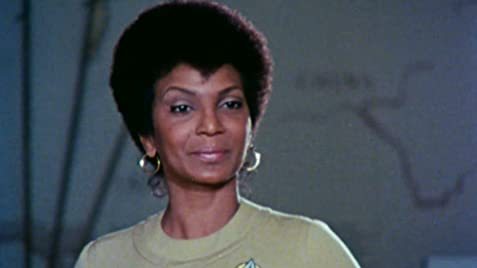

Anyway, what I'm saying is Michael's journey chronicled through her hair is as much about Star Trek itself as it is about her.
2K notes
·
View notes
Note
Trick or trivia
Happy Halloween! I do enjoy trivia of many types, but one of my favorite genres is what I call the Berenstein Timeline: unmade shows and movies, versions of classic movies where studios and producers made different decisions, some better, some much worse. All of these are real projects that were, on some level, considered (there are some recurring names)
"Heat Vision & Jack", a 90s pastiche of 70s-80s action shows starring Jack Black as an astronaut on the run from the law and Owen Wilson as his talking motorcycle
"Jurassic Park" directed by Tim Burton with Johnny Depp as Alan Grant, Jim Carrey as Ian Malcolm, and Vincent Price as John Hammond
the 90s "Batman" directed by Ivan Reitman; Bill Murray and Eddie Murphy were going to star but couldn't decide which of them would be Batman and which would be Robin
Back in the 1970s the American network was getting good numbers showing heavily-edited reruns of "Monty Python's Flying Circus", so they tried to sell the Pythons on the next logical step: an animated Saturday morning cartoon
"Edward Scissorhands" still directed by Burton but starring Tom Cruise or maybe Michael Jackson
"Return of the Jedi" directed by David Lynch; Harrison Ford was considering not coming back for the third movie and so when he came out of the carbonite there was a chance he would have been Christopher Walken
Guillermo del Toro's "At the Mountains of Madness". Also "the Hobbit" and lots of other things, he seems to have a lot of unmade projects
the 2010s "Star Trek" movie directed by Quentin Tarantino, where the edgy reboot crew visits the Gangster Planet from that one stupid episode of the original series
Everybody knows about the unmade "Superman Lives" starring Nicolas Cage in the title role, but did you know it was going to be directed by Tim Burton and include Christopher Walken as Brainiac, who would have been a green head on spider legs
Harold Ramis didn't particularly want to act on camera, so when they were casting "Ghostbusters" Egon could have been Christopher Walken, Christopher Lloyd, Jeff Goldblum, or John Lithgow. Supposedly the movie was originally intended to be a relatively serious exploration of Dan Akroyd's very real interest in paranormal investigation, although this clashes a bit with the fact that Peter Venkman was originally going to be played by John Belushi and Winston Zeddmore was written for Eddie Murphy who backed out when the character's backstory and most of his lines were cut
John Waters' animated series "Uncle John" on 90s MTV
the original version of "Bill & Ted's Time Van" starring Pauly Shore and Sean Penn
"Red Dragon" (the original Hannibal Lecter novel) directed by David Lynch starring John Lithgow as Hannibal Lecter and Mel Gibson as Will Graham
the 1970s "Dr. Strange" TV series
the 1990s Disney animated "John Carter of Mars"
the 1990s Warner Bros animated "King Tut" musical with songs by Prince
the serious horror version of "Beetlejuice"
Drew Barrymore's 2000s remake of "Barbarella"
the Dungeons & Dragons movie James Cameron was going to make until TSR left the table over merchandising disputes, forcing Cameron to go work on some dumb movie about the Titanic
American "Doctor Who" movie starring Michael Jackson
Canadian "Doctor Who" cartoon by Nelvana starring a Doctor based intensely off of either Jeff Goldblum or Christopher Lloyd
"Harry Potter and the Philosopher's Stone" directed by Terry Gilliam
"Good Omens" directed by Terry Gilliam and starring Johnny Depp and Robin Williams
"The Black Cauldron" using character and background designs by Nightmare-era Tim Burton
106 notes
·
View notes